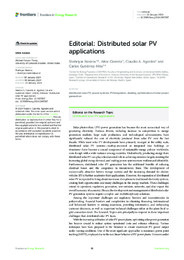Please use this identifier to cite or link to this item:
https://hdl.handle.net/11000/34857Full metadata record
| DC Field | Value | Language |
|---|---|---|
| dc.contributor.author | Nasirov, Shahriyar | - |
| dc.contributor.author | Ciarreta, Aitor | - |
| dc.contributor.author | Agostini, Claudio A. | - |
| dc.contributor.author | Gutiérrez-Hita, Carlos | - |
| dc.contributor.other | Departamentos de la UMH::Estudios Económicos y Financieros | es_ES |
| dc.date.accessioned | 2025-01-17T11:18:34Z | - |
| dc.date.available | 2025-01-17T11:18:34Z | - |
| dc.date.created | 2024-01 | - |
| dc.identifier.citation | Front. Energy Res., 22 January 2024 | es_ES |
| dc.identifier.issn | 2095-1698 | - |
| dc.identifier.issn | 2095-1701 | - |
| dc.identifier.uri | https://hdl.handle.net/11000/34857 | - |
| dc.description.abstract | Solar photovoltaic (PV) power generation has become the most economical way of generating electricity. Various drivers, including increase in competition in energy generation markets, large scale production, and technological advancements, have significantly reduced the cost of electricity produced from solar PV over the last decade. While most solar PV developments have primarily emerged at the utility scale, distributed solar PV systems—rooftop-mounted or integrated into buildings or structures—have become a crucial component of sustainable energy policies worldwide, even though with a wide variance among countries. Undoubtedly, producing energy from distributed solar PV can play a fundamental role in achieving emission targets, meeting the increasing global energy demand, and making power systems more resilient and affordable. Furthermore, distributed solar PV generation has the additional benefits of reducing electrical losses and the congestion in transmission lines. The development of economically attractive battery storage systems and the increasing demand for electric vehicles (EVs) further accelerate their applications. However, the expansion of distributed solar PV is expected to bring about enormous disruptions to traditional electricity systems, creating both opportunities and many challenges in the energy markets. These challenges extend to operators, regulators, generators, new entrants, networks, and also impact the overall economy of acountry. Hence, thedevelopment andmanagementofdistributed solar PV generation systems require complex and multidisciplinary solutions. | es_ES |
| dc.format | application/pdf | es_ES |
| dc.format.extent | 2 | es_ES |
| dc.language.iso | eng | es_ES |
| dc.publisher | Frontiers Media | es_ES |
| dc.rights | info:eu-repo/semantics/openAccess | es_ES |
| dc.rights.uri | http://creativecommons.org/licenses/by-nc-nd/4.0/ | * |
| dc.subject | distributedsolarPV | es_ES |
| dc.subject | powersystems | es_ES |
| dc.subject | PVintegration | es_ES |
| dc.subject | shading | es_ES |
| dc.subject | optimization of solar power generation | es_ES |
| dc.subject.other | CDU::3 - Ciencias sociales::33 - Economía::338 - Situación económica. Política económica. Gestión, control y planificación de la economía. Producción. Servicios. Turismo. Precios | es_ES |
| dc.title | Editorial: Distributed solar PV applications | es_ES |
| dc.type | info:eu-repo/semantics/article | es_ES |
| dc.relation.publisherversion | https://doi.org/10.3389/fenrg.2024.1367587 | es_ES |

View/Open:
fenrg-12-1367587 (1).pdf
500,58 kB
Adobe PDF
Share:
.png)
